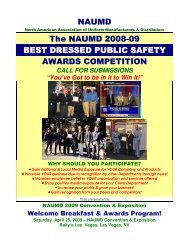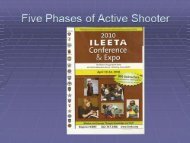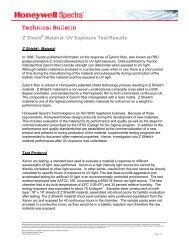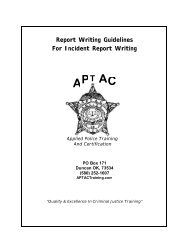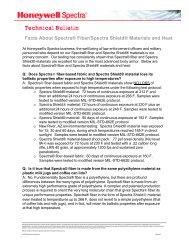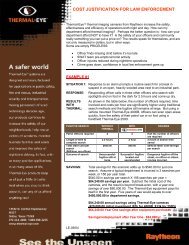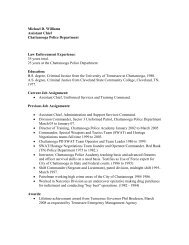The National Vehicle Location Service
The National Vehicle Location Service
The National Vehicle Location Service
You also want an ePaper? Increase the reach of your titles
YUMPU automatically turns print PDFs into web optimized ePapers that Google loves.
<strong>The</strong> Information Source For<br />
Law Enforcement And Homeland Security<br />
SEPTEMBER/OCTOBER 2010 PUBLISHED BY DAYS COMMUNICATIONS, INC. VOL. 26 ISSUE 5<br />
Stolen vehicles, felony wants, and Amber alerts are all compelling<br />
reasons to adopt automated License Plate Reader (LPR)<br />
technology. Patrol officers can quickly and easily download critical<br />
information for traffic stops or calls for service, enhancing both<br />
their own and the public’s safety.<br />
However, for the technology to become a strategic part of<br />
interoperability efforts among North American federal, state, and<br />
local Law Enforcement Agencies (LEAs), a shared LPR historical<br />
database must be in use and it must be available to every agency –<br />
regardless of whether they have their own LPR systems.<br />
A large, centralized, geographically diverse shared LPR database,<br />
which receives tens of millions of new vehicle locations each<br />
month, is a resource many police departments have only dreamed<br />
of; yet, Vigilant Video Inc., together with <strong>National</strong> <strong>Vehicle</strong> <strong>Service</strong><br />
(NVS, ORI #VANVS005V), has made this high-tech intelligence<br />
tool a reality – for free.
A typical data intelligence report<br />
of a stolen vehicle from Los Angeles<br />
Serving the Public Good<br />
Since the <strong>National</strong> <strong>Vehicle</strong> <strong>Location</strong> <strong>Service</strong> (NVLS) Web portal<br />
(http://nvls-lpr.com/nvls) launched in the second quarter of<br />
2010, hundreds of local, state, and federal LEAs have signed on.<br />
<strong>The</strong> database isn’t just for agencies with existing automated<br />
LPR systems which hope to host their LPR data in a secure national<br />
sharing repository. Instead, the NVLS provides all agencies<br />
with access. Participating agencies can not only opt to just share<br />
each other’s public LPR data, but they may also opt for access to<br />
Vigilant Video’s ever growing national private LPR database.<br />
<strong>The</strong> NVLS database contains over 185 million vehicle location<br />
records and more than 23 million new locations are added<br />
each month. <strong>The</strong> database’s overwhelming intelligence value motivated<br />
Vigilant Video (through NVS) to rapidly enable no cost<br />
distribution of vehicle location searches via direct law enforcement<br />
Nlets queries. Perhaps most importantly, the <strong>National</strong> Center<br />
for Missing and Exploited Children (NCMEC) has access,<br />
enabling NCMEC agents to utilize the database while investigating<br />
their cases.<br />
As Vigilant Video’s Vice President of Sales and Marketing,<br />
Joe Harzewski, puts it, “NVLS as a national security asset has wins<br />
across the entire United States. With most every federal agency<br />
and most large metro area law enforcement agencies participating<br />
as NVLS members, we are supporting thousands of vehicle location<br />
searches every month which have resulted in hundreds of<br />
arrests, or an apprehension rate of between 40 and 80 percent,<br />
Page 2<br />
depending on the LEA’s speed in responding to the data. <strong>The</strong> most<br />
exciting part is that NVLS has only just begun to scratch the surface<br />
of public good.”<br />
Where the Private Data Come From<br />
Private LPR data come from thousands of vehicles, or “spotter<br />
cars,” equipped with LPR cameras used by LPR Fleet Operators<br />
(LFOs). LFOs gather vehicle license plate data anywhere vehicles<br />
can reasonably be expected to remain for some time or return in<br />
the future. (Conversely, LEAs collect license plate data which, to<br />
a large extent, corresponds to vehicles in transit and may not be of<br />
high forensic intelligence value.) Vigilant Video’s business supports<br />
LFOs with software, hardware, and mapping systems, all of<br />
which expedite the data collection process by showing LFOs when,<br />
and where, to collect data.<br />
Vigilant Video’s private LPR database boasts 185 million plus<br />
records from vehicles nationwide. Vigilant currently adds more<br />
than 23 million private LPR records per month to its database. By<br />
the end of 2010, the company expects to attain a new data add rate<br />
of more than 30 million records per month, for a total of 200 million<br />
additional records added during CY 2010, all of which flow<br />
into the database in a real-time, constantly updating stream.<br />
Accessing the Data<br />
Both public and private LPR data are distributed through Nlets,<br />
but may also be accessed on-line via the NVLS Web portal. <strong>The</strong><br />
means for granting access comes from a sophisticated registration<br />
process, whereby NVLS administrative personnel validate each<br />
LEA user applicant. Each valid NVLS user account is then synchronized<br />
with Vigilant’s proprietary Law Enforcement Archival<br />
Reporting Network (LEARN-NVLS) so that users can look up<br />
applicable location data via the NVLS Web portal.<br />
LEARN-NVLS manages three key categories of LPR related<br />
data:<br />
1. Detection records – <strong>The</strong>se are records obtained from LPR<br />
equipped vehicles. <strong>The</strong>y include the following attributes: color<br />
overview image; IR license plate image; license plate Optical Character<br />
Recognition (OCR) result; date/time stamp; location data;<br />
camera/system information; user information; and nearest address.<br />
2. Hot lists – <strong>The</strong>se are “vehicles of interest” and contain<br />
license plate number source files, associated vehicle data, and<br />
alert types.<br />
3. Hit records – <strong>The</strong>se are detection records matched with<br />
applicable hot list records.<br />
<strong>The</strong> database itself, together with the NVLS plate lookup portal<br />
and the LEARN-NVLS LPR database end user Web interface,<br />
is hosted within a highly secure Northern Virginia data<br />
center facility.<br />
Scalable Information Sharing<br />
Participating LEAs with automated LPR systems are encouraged<br />
to leverage NVLS to share their LPR data, although they do<br />
not have to in order to attain an NVLS user account. However,<br />
because LEARN-NVLS allows law enforcement agencies their own<br />
data storage, they do not have to maintain their own LPR data<br />
ecosystem or storage infrastructure which can be costly – both up<br />
front and over time.<br />
Data are maintained via agency accounts which include unlimited<br />
users’ accounts, along with an administrator’s account. This is<br />
used to manage technical maintenance and user information including<br />
permission. Permission includes the rights to view and edit<br />
data; e.g., detections, hits, hot lists, mapping utilities, and data
Stolen vehicle locations<br />
based on three weeks of reported data<br />
mining tools. All of these aspects ensure that transaction accountability<br />
is maintained per NCIC requirements.<br />
Agencies which do host LPR data within LEARN-NVLS are<br />
solely responsible for determining how their data are accessed and<br />
(if they desire) shared. In fact, participating LEAs can even determine<br />
how long their data will be stored on the LEARN-NVLS<br />
server before it is archived or deleted.<br />
From here, law enforcement agencies can choose to share data<br />
with only certain designated NVLS participants or with all other<br />
valid LEARN-NVLS LEA entities. <strong>The</strong> database, built on<br />
Microsoft ® ’s SQL Enterprise, allows for fast queries, less network<br />
traffic, and no server “nodes” on which many other information<br />
sharing schemes rely.<br />
Vigilant Video’s LPR systems were specially designed with in<br />
vehicle plug and play network technology to allow for national<br />
LPR data sharing and to enable live, real-time network-based hot<br />
list synchronization with national databases. <strong>The</strong> Vigilant in car<br />
LPR application is so advanced that one officer can add a hot<br />
plate and, moments later, have that hot plate on a live department<br />
(or even nationwide) LEA watch list which is accessible to US<br />
investigators who may assist in locating the hot listed vehicles.<br />
From Data to Results<br />
<strong>The</strong> success of NVLS and Vigilant Video’s national LPR data<br />
server remains unparalleled. Almost daily, the NVLS administration<br />
receives voluntary success stories highlighting results of this<br />
new and innovative approach to LEA practices.<br />
• Houston, TX – “A hit-and-run homicide vehicle was spotted<br />
by the NVLS system. Hours later, the perpetrator was apprehended<br />
at a pay by the month, extended stay hotel.”<br />
• Chicago, IL – “An armed robbery occurred and witnesses<br />
noted the license plate on the fleeing vehicle; the NVLS historical<br />
database located the perpetrator’s residence, resulting in apprehension<br />
a few hours later.”<br />
• Sacramento, CA – “Our unit just recently located two vehicles<br />
under cargo theft investigation which were found at the reported<br />
NVLS locations.”<br />
• Phoenix, AZ – “Our bomb squad has verified that our target<br />
vehicle is in Austin as of last night.”<br />
• Scottsdale, AZ – “We have found two different shooting suspects<br />
and an armed robbery suspect based on the history which the<br />
NVLS Web site provided us.”<br />
• State of MD – “In less than ten minutes of signing up for the<br />
NVLS service and running my first tag, I received information on<br />
a critical lead in a case for one of my subordinates.”<br />
• Bellevue, WA – “In June, patrol officers responded to a residential<br />
burglary. A witness provided a license plate of a fleeing<br />
suspect. A registration query via Nlets led to the information in<br />
NVLS.”<br />
• Fairfax, VA – “Within the first two weeks of using the NVLS<br />
database, we recovered three stolen vehicles – one of which led to<br />
a large amount of stolen property, including iPod ® s, GPS units,<br />
credit cards, and other electronics.”<br />
About the Author: Christa M. Miller (http://christammiller.com)<br />
is a freelance writer and public relations consultant based in South<br />
Carolina. She specializes in law enforcement and digital forensics<br />
issues.<br />
Page 3





